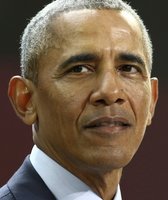Stand up for the facts!
Our only agenda is to publish the truth so you can be an informed participant in democracy.
We need your help.
I would like to contribute
We have cut 'our deficits by almost three-quarters,' Obama says in State of the Union
A year ago, President Barack Obama said during his 2015 State of the Union address that the United States has seen "our deficits cut by two-thirds" during his tenure. We rated that claim Mostly True. During his 2016 State of the Union address, Obama raised the bar.
After citing some of his administration’s economic accomplishments, he said, "We’ve done all this while cutting our deficits by almost three-quarters."
Has the deficit-reduction expanded during the past year? We took a closer look.
Let’s start with an important reminder: The deficit is not the same as the debt.
A country’s deficit is the difference between what the government collects in revenues and spends in one year. The national debt, by contrast, is the accumulation of all annual deficits minus any annual surpluses.
When we checked Obama’s assertion a year ago, he compared his first budget year in office -- 2009 -- to 2014, using the deficit as a percentage of gross domestic product, or GDP. Economists consider this a valid way to measure the size of the deficit -- in fact, for most purposes, it’s the best way, since it factors in the economy’s change over time.
Here’s the recent history of the deficit as a percentage of GDP. The years 2009 through 2014 come from historical data maintained by the Office of Management and Budget. The 2015 figure is the most recent estimate by the nonpartisan Congressional Budget Office, released in August 2015.
Fiscal year
Deficit as a percentage of GDP
2009
9.8
2010
8.7
2011
8.5
2012
6.8
2013
4.1
2014
2.8
2015
2.4
According to this data, the deficit as a percentage of GDP has fallen by 76 percent -- almost exactly what Obama said.
If you use dollars rather than percentage of GDP, the decline is a bit smaller but still pretty close -- 70 percent.
That said, experts have told us that while Obama's math may be correct, it's missing some important caveats.
First, it's important to note that the deficit swelled in 2009 partly because of the massive stimulus program to jumpstart the cratering economy. This temporarily elevated level set the stage for the unusually precipitous decline.
"This is not to say that that the large deficit was his fault, but if one used the 2008 deficit as a frame of reference, the comparison would be quite different," Alan Auerbach, University of California Berkeley professor of economics and law, told us a year ago.
Also, some economists we’ve consulted pointed out that the 2009 fiscal year was Obama’s first year in office, and so not necessarily a good starting point since he had little control over the spending in that year.
There's another issue. Princeton University economics professor Harvey Rosen told us the more important question is whether Obama has put the government on a path that will keep deficits stable.
"And the answer is no," Rosen said, because entitlement programs, such as Medicare, Medicaid and Social Security, have not had substantial reform.
The long-term forecast for the deficit illustrates this point. Absent substantial reform, the Congressional Budget Office expects a few more years of short-term deficit decreases followed by bigger shortfalls in 10 and 20 years.
The most recent projections show deficits as a percentage of GDP remaining lower than today’s level through 2018, then beginning an upward curve. Between 2019 and 2022, the deficit is set to rise from 2.8 percent of GDP to 3.7 percent of GDP. It is not projected to fall below 3.4 percent through 2025.
We should also note that the picture on the debt is not as rosy as it is for the deficit. When Obama took office, the debt held by the public stood at $6.3 trillion. Since then, it has more than doubled to $13.6 trillion.
Finally, presidents don’t move the economy on their own (the economy can be affected for good or ill by global trends and technological change) and must cooperate with Congress when steering fiscal policy.
Our ruling
Obama said we have cut "our deficits by almost three-quarters."
The numbers check out if you start with fiscal year 2009, his first year in office. But it’s worth remembering that 2009 had a historically high deficit, and that projections show the deficit increasing again in just a couple years.
We rate the claim Mostly True.
Our Sources
Barack Obama, State of the Union address, Jan. 12, 2016
Office of Management and Budget, Table 7.1—Federal Debt at the End of Year: 1940–2020, accessed Jan. 12, 2016
Office of Management and Budget, Table 1.1—Summary of Receipts, Outlays, and Surpluses or Deficits (-): 1789–2020, accessed Jan. 12, 2016
Office of Management and Budget, Table 1.2—Summary of Receipts, Outlays, and Surpluses or Deficits (-) as Percentages of GDP: 1930–2020, accessed Jan. 12, 2016
Treasury Department, Debt to the Penny calculator, accessed Jan. 12, 2016
Congressional Budget Office, "August 2015 Baseline," From An Update To The Budget And Economic Outlook: 2015 To 2025
PolitiFact, "Barack Obama claims deficit has decreased by two-thirds since taking office," Jan 20, 2015
Email interview with Steve Ellis, vice president of Taxpayers for Common Sense, Jan. 11, 2016
Browse the Truth-O-Meter
More by Louis Jacobson
We have cut 'our deficits by almost three-quarters,' Obama says in State of the Union
Support independent fact-checking.
Become a member!
In a world of wild talk and fake news, help us stand up for the facts.








































